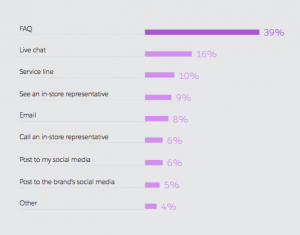Why is customer service important to business? Consider this statistic: each year US businesses lose an estimated $41 billion from poor customer service.
Then there’s the fact that customers have high expectations and will act if they are disappointed: 93% of us will take action following inadequate service.
What might that action entail? According to New Voice Media:
- 59% of 25 to 34-year-olds share poor customer experiences online
- 34% will post a negative review online
- 58% will never use the company again
- 49% will tell friends not to use the business
In its 2015 State of Service: Insights on Customer Service Trends, Salesforce’s 1,900 industry leader survey respondents identified 3 top customer service challenges:
- customers having to re-explain their issue (51%)
- customers expending moderate to high effort to resolve an issue (46%)
- customers failing to find answers on their own as key issues (40%)
Self-Service Customer Service
More than 1/3 of millennials would prefer to get their teeth cleaned rather than call a customer service line, according to a desk.com survey. Some 39% of them are most likely to check an FAQ first if they have questions. Live chat was a distant second at 16%.

This do-it-yourself preference is not only seen among millennials. Some 41% of all respondents, regardless of generation, check the FAQ first. Also, 80% of Boomers and Gen Xers considered having to deal with customer service over the phone inconvenient.
When they do reach out for service, customers of all ages expect a prompt response. Millennials were willing to wait on hold 5 minutes longer than GenXers and Boomers for customer service help. Still, the majority (60%) of respondents see 5 minutes or less as an acceptable wait time.
“Today’s customers demand seamless, individualized interactions across all devices and channels. This ‘new normal’ creates an expectation for customer service to be equally nimble and responsive.” — SalesForce
Losing Brand Loyalty
While millennials are more patient waiting on the phone, they are more likely to leave a brand after a single bad support interaction. On average it would take three bad support interactions for a customer of other generations to stop using the brand.
A bigger issue, perhaps, for the small business owner is the standardization of expectation. “Increasingly, customers expect from all players the same kind of immediacy, personalization, and convenience that they receive from leading practitioners such as Google and Amazon,” a recent McKinsey report noted.
Customers today expect top-notch service and demand responses whenever they need it in whichever medium they want it. Being responsive across all channels, empowering service agents to make customers happy, and working to predict customer service needs all can help to earn and retain customer loyalty. VoIP business phone systems with call recording, call queue management, and other features can help to keep your customer service department accountable, allow you to accurately identify common pain points, and ensure both transparency and a timely resolution of the issue at hand. Keeping your clients happy secures future business for your company, and providing quality customer service is the best way to make that happen.
Sources:
desk.com (n.d.) Crossing the generational divide: providing customer service for today’s consumers. http://www.desk.com/success-center/desk-crossing-generational-divide-infographic
McKinsey Quarterly (2016, August). The CEO guide to customer experience. http://www.mckinsey.com/business-functions/operations/our-insights/the-ceo-guide-to-customer-experience
New Voice Media (2014). The multibillion dollar cost of poor customer service [INFOGRAPHIC]. http://www.newvoicemedia.com/blog/the-multibillion-dollar-cost-of-poor-customer-service-infographic/
Salesforce. (2015, November 27). State of Service: Insights on customer service trends from over 1,900 industry leaders. https://www.salesforce.com/blog/2015/11/2015-state-of-service-infographic.html
